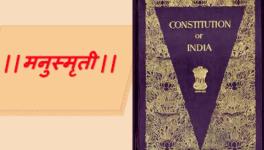Ali Ibrahim Khan and Narendra Modi: the Past and Present of Kashi Vishwanath
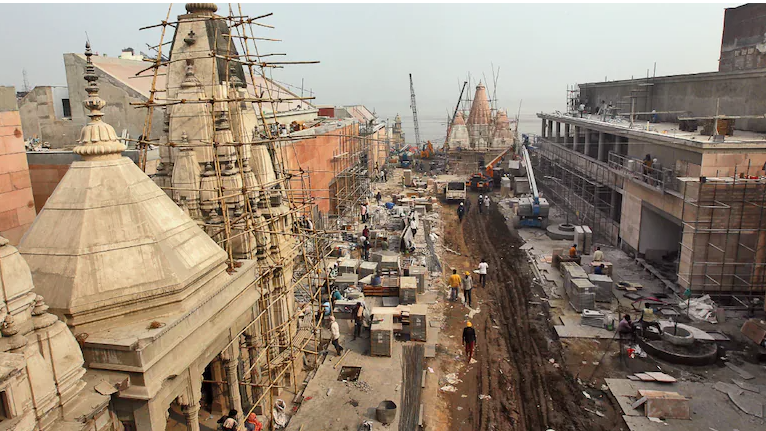
Image Courtesy: India Today
The Prime Minister Narendra Modi stands on the site where once stood the old Kashi Vishwanath corridor and hundreds and thousands of houses, shops, heritage, and religious structures that have now been demolished. He stands there thumping his chest with pride while giving himself the credit of liberating Baba Vishwanath through the demolishments and a sea of saffron-clad saints, few of whom have lost their livelihood homes or site of worship to the ambitious Kashi Vishwanath corridor Project, cheer him on.
One, of course, wonders what is there to cheer on when so much history has been reduced to dust along with people's livelihoods.
The Prime Minister thanks Maharani Ahilya Bai Holkar and Maharaja Ranjit Singh for being the inspiration behind the Kashi Vishwanath Corridor Project. However, he fails to mention that the construction of the actual corridor, which is what the prime minister is doing, is not in the portfolio of either of these people.
Maharani Ahilya bai Holker constructed the present Vishwanath Temple in the 18th century, while Maharaja Ranjit Singh donated the gold for the dome. The corridor along with the Naubat-Khana was constructed by Nawab Ali Ibrahim Khan Bahadur Khaleel of Doolighat. In a way, he is the true predecessor of the Prime Minister with respect to his ambitions.
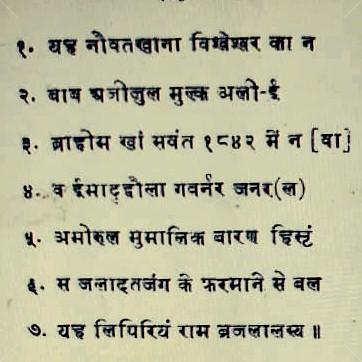
Inscription
In this light, it is interesting to do a comparative analysis of the construction of both corridors.
Nawab Ali Ibrahim Khan Bahadur 'Khaleel' was the nephew of Nawab Haji Syed Ahmad Ali Khan Bahadur 'Qayamat' of Azeemabad and founder of the Doolighat Estate. Khan, a Mansabdaar in Emperor Shah Alam II's court, was the noblest advisor to the Nawab of Bengal, Mir Qasim Aali Jah and the Naib Subedar of Bihar. He was also a very dear friend to the then ruler of Banaras, Raja Chait Singh.
According to the book A Narrative of the Insurrection which Happened in the Zemeedary of Banaris by Warren Hastings, he was appointed as the Chief Magistrate of Banaras in 1781 after the rebellion of Raja Chait Singh. Later he served as Governor of the same till his demise in 1795, leading to communal agitation. It was then that Khan took up the Project to construct a pathway to the Kashi Vishwanath Temple to restore communal harmony and ensure that the Hindu population of the area felt safe under his leadership. His attempt was never to "restore pride" or "show the other communities their place" or establish his community's supremacy.
On the other hand, the prime minister repeatedly and boisterously asserts that the new Kashi Vishwanath Corridor aims to establish the supremacy of the sanatanis and increase the grandeur of the Hindu population. His speech did not carry a single reference to the heightened communal tensions in Banaras. There was no attempt by the Prime Minister to make the Muslim population feel safe. Instead, this was a loud and clear message that he intends on returning India to a time when Sanatan was the only religion here. His speech is a thinly veiled threat. It is a clear nod to the slogan "Ayodhya to bass jhanki hai, Kashi Mathura baaki hai."
In his drive to repeat Ayodhya in Banaras, the Prime Minister intends on sparing no costs. Neither does he plan on letting anyone off the hook.
He cleverly states that the people have "donated" land for Baba Vishwanath, and if you see at the settlement price offered to people to empty the area, you too would agree that the land is a donation and not a fair trade. People have been offered 40 lakhs to empty their houses in a prime location in the city. Today, a house in Banaras in the same area costs almost twice as much. Apart from this, most shops there dealt in things that had something to do with either the temple or the cremation site near it. Now those vendors have practically been rendered jobless because it is tough to find a shop in a similar location again in Banaras at the price of only 40 lakhs.
A more rationalist onlooker would say that demolishments are the rule whenever a new construction happens. How else will we develop? And they would have a point in saying that too.
Khan too demolished several houses and shops which were obstructing the way to the temple. However, his approach to the procurement of land was very different. Each house owner either willingly donated their land or was negotiated with until a fair deal was agreed upon. In the documents related to the construction of the corridor, we find the mention of a man who refused to part with his property till death. In that case, Khan halted the construction and waited for the man to agree. The house was finally acquired after three years when the man died, and his son then agreed to sell the land for the corridor.
In this period, Hastings got transferred out of India. Khan still proceeded with the construction of the corridor. The British government later offered him reimbursement for the costs incurred by him during the Project, but Khan refused. He built the entire corridor at his expense. One cannot say the same about the BJP government.
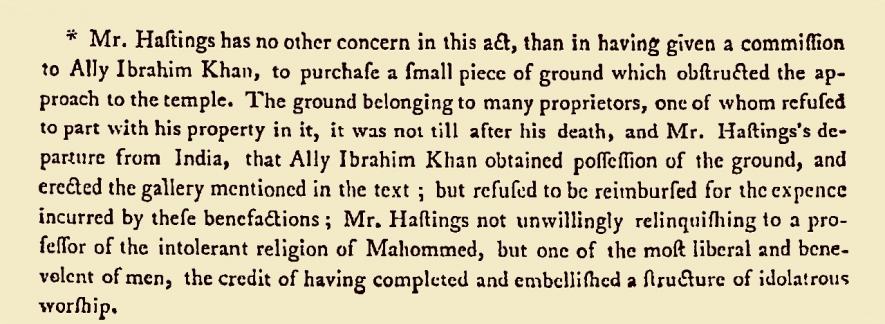
Footnote from Warren Hastings' Trial Record
But then again, the purpose that the structures are supposed to serve are very different. Khan constructed the Naubat-Khana so that everyone could access the Jhanki of Baba Vishwanath across religions. Apart from this, the Naubat-Khana was supposed to serve as a music gallery where artists of all backgrounds worshipped Vishwanath and their art.
Modi's aims are very different. He, unfortunately, did not even need to construct the new corridor to achieve them. The Kashi Vishwanath space had already turned into a very volatile Hindu supremacist space long ago. A space where now even the descendants of Khan do not venture.
"I tried visiting the Naubat-Khana once sometime in 2019," recalls the co-author Ali Fraz, a relative of Khan from Doolighat.
"I wanted to document the Naubat-Khana before it was demolished. Take some pictures for keepsakes. I decided to go there despite several warnings from friends and relatives. Nobody agreed to accompany me, so I went alone. I reached the site and started walking towards the temple. I had to inquire about the location of the Naubat-Khana because I had never been there. I was constantly interrogated by everyone I asked for directions. People took one good look at my kurta, shawl, beard, 'the quintessential Muslim look' and got vigilant. I was even questioned by the police personnel at the site. At last, I was forced to leave without even having a look at the soon to be destroyed monument. I felt like a trespasser on a road that my ancestors quite literally paved for me to use."
Khan was the person behind the renovations of the Alamgir Mosque and the Dharahra Masjid. A fine scholar of Law with works such as Fatwa-e-Ibrahim-Khani (Muslim Personal Law) and Trial by Ordeal (Hindu Personal Law). An important figure in literature, with books and tazkiras namely Khulasa-tul-Kalam (Biography of Persian Poets), Suhuf-e-Ibrahim (Biographies and selections from Persian Poets), Gulzar-e-Ibrahim (Biographies and selections from Urdu Poets) and historical works Tarikh-e-Maratha, Sawanah-e-Haider Ali and Sawanah-e-Chait Singh.
Despite his contribution, his name has been erased from the history of Kashi Vishwanath and Benares.
After his demise, positions were passed on to his son Nawab Naseer-ad-Daulah Naseeruddin Ali Khan 'Naseer' and then to his grandson Nawab Iqbal-ad-Daulah Enayat Hussain Khan' Mahjoor', who later lost the English titles for their participation in the rebellion of 1857.
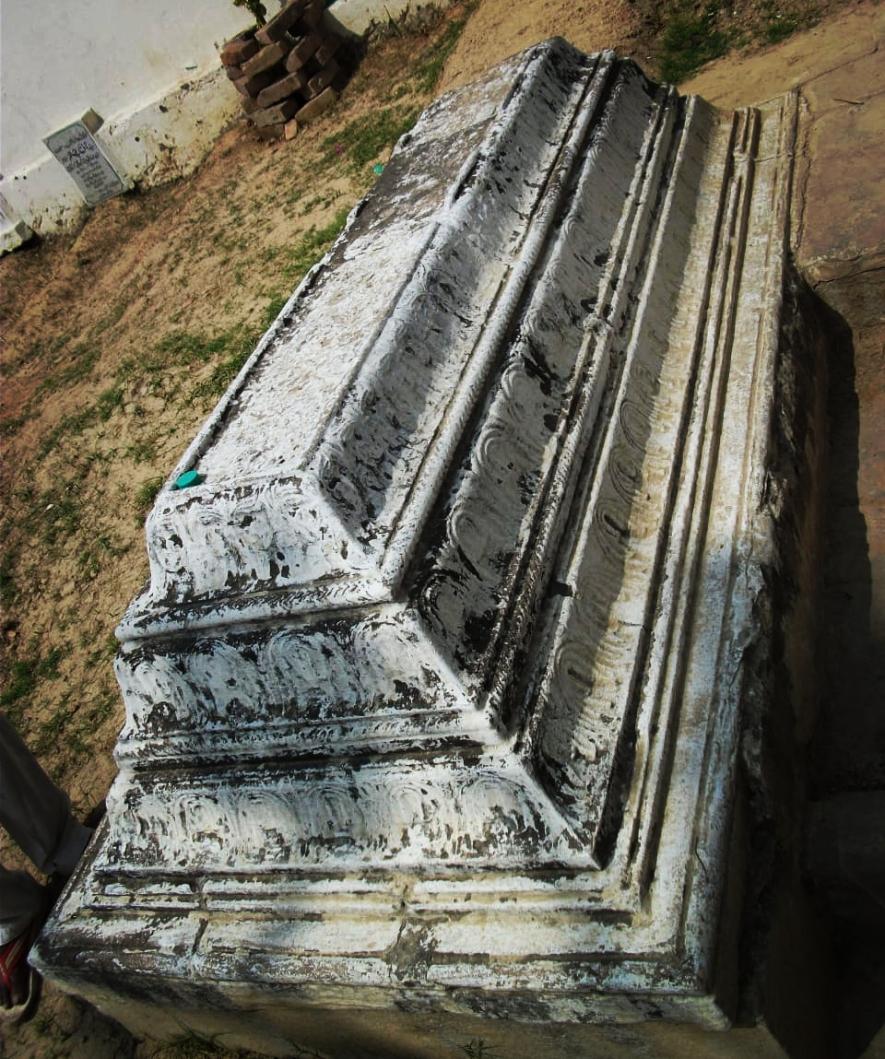
grave of Ali Ibrahim Khan
Khan's grave in Fatmain was demolished a few years ago. His name appears nowhere in the history of Banaras. Many such accounts and people are now buried under Modi's dream project. Many more such histories await their demolition.
Ali Fraz Rezvi is a theatre artist and a student of Social Work at Delhi University. Shivangi Pandey is a student of English (Hons.) at Jamia Millia Islamia.
Get the latest reports & analysis with people's perspective on Protests, movements & deep analytical videos, discussions of the current affairs in your Telegram app. Subscribe to NewsClick's Telegram channel & get Real-Time updates on stories, as they get published on our website.










